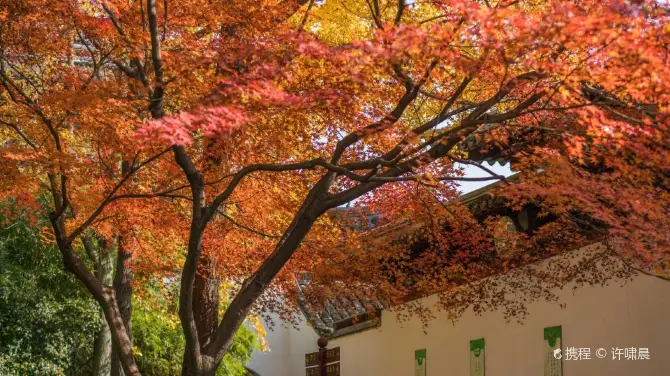




Description
Xiyuan Temple has many aliases. Open Baidu or Google Maps, and the Jiezhuanglu Temple, Xiyuan Ancient Temple, and Xiyuan indicated on the map all refer to Xiyuan Temple, the same place. The temple was built in the Yuan Dynasty to the first year (1264-1294 AD), formerly known as Guiyuan Temple, and the existing building was rebuilt in the Qing Dynasty. During the Jiajing period of the Ming Dynasty, it was once converted into a private garden by Xu Taishi, the builder of the Lingering Garden, Taipu Siqing. Now the temple is a temple garden in Suzhou City, and the architectural features of the combination of temples and gardens should be influenced by the Ming Dynasty. The main buildings of the temple are all on the north-south central axis, and you can visit them one by one along the central axis. On the south side of the temple is the Zhaobi with the words "Jiezhuanglu Temple", the north side of the Zhaobi is the Fude Bridge and the Wisdom Bridge that span the Shangtang River. , the vertical plaque above the archway "Zhen Guo Jie Building" was given by Emperor Guangxu of the Qing Dynasty. To the north of Yuci Archway is the mountain gate. Entering the mountain gate means entering the temple. First see a large square, full of pines and cypresses. There are many ancient trees in Xiyuan Temple, such as camphor and ginkgo trees with a history of more than 100 years. Going north along the Yongdao Road, there are bell towers and drum towers on the east and west sides of the road. After walking through the corridor, you can see the Mahavira Hall. The Sanbaolou at the north end is the Book Collection Pavilion, which is not displayed to the outside world. There is the Guanyin Hall on the east side of the Daxiong Hall, and the Wubai Luohan Hall on the west side is a building worth seeing in the temple. There are 500 statues of Arhats in the Qing Dynasty covered in gold, with different shapes. After worshiping the 13-meter-high Thousand-handed Avalokitesvara carved from camphor wood in the middle of the hall, the special activity of "counting Arhats" began. Men on the left and women on the right, choose one that you like and start counting, and count one by one until you stop at your virtual age. The Arhat in front of you represents your life. Remember the serial number of the Luohan, go to the entrance of the Luohan Hall and ask for a corresponding Luohan card with an annotation and signature on it. There is a statue of Jigong on the south side of the Arhat Hall, and a statue of a mad monk on the north side. The belts and folds of the two statues seem to be the same. According to legend, they are the beautiful works of the two teachers who led the class who shaped the statues of five hundred Arhats. Then go west, and the West Garden in the west of the temple is also a major attraction. This is a place with a strong Suzhou garden style. In the middle is a tadpole-shaped release pond, with its head facing south, its tail facing north, and its tail extending to the southeast. The architectural features of the waterscape are exactly the same. In the middle of the lake is the Huxin Pavilion, plus the surrounding rockeries and pavilions, it is no longer like a temple. The two turtles in Ming Dynasty, which have lived for more than 400 years in the release pond, have always been a topic of conversation among tourists. The turtles are very precious, and there are few in the world. It is a pity that one of them died in 2007. There is a bronze statue of a giant turtle in the southwest corner of the release pond. Tourists who cannot see the turtle can take a photo with the bronze statue to make up for their regrets. The "Simian Hall" on the east side of the Free Life Pond is a place for the circulation of French goods, where you can buy Buddhist souvenirs such as Buddhist beads. There are two wisterias in the Ming Dynasty on the terrace of the four-sided hall, more than 400 years old, and there is a wisteria more than 500 years old on the south side. The Dharma Promotion Department in the south of the West Garden can receive free Buddhist sutra booklets. Xiyuan Temple is a temple that is said to be very effective in making wishes among Suzhou locals, and you can pray here. On the first and fifteenth day of the new year, there are many pilgrims; the incense is especially strong during the Spring Festival, and many pilgrims come to burn the first incense on the first day of the new year. On the birthdays and anniversaries of various bodhisattvas, the temples will also hold pujas. There is a vegetarian hall in the temple, which is on the west side of Tianwang Hall and south of Wubai Luohan Hall. There are only three kinds of noodles, Ruyi noodles, Luohanzhai noodles, and Guanyin noodles, which cost only 10 yuan per person. There is a merit forest outside the temple. The old vegetarian restaurant is slightly more expensive than the one in the temple. The vegetarian chicken and "sweet and sour pork ribs" are delicious. There is Hanshan Temple in the west of Xiyuan Temple, Lingering Garden in the east, Dingyuan Garden and Tiger Hill in the north. You can arrange the tour route according to your own preferences.






















